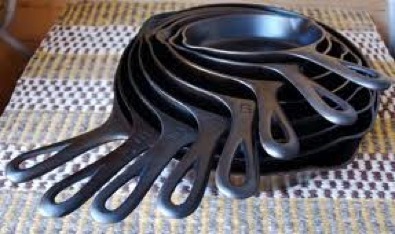
Black cast iron pans are green because they last so long
Cast Iron Pans: Yesterday is tomorrow
Many books have been written about cast iron cookware. I will try to say a few things here perhaps not said elsewhere.
Buying
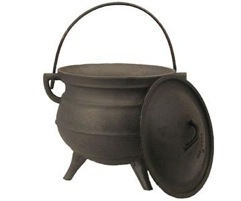
Cauldron with legs and lid for large jobs
I rarely buy new cast iron, for several reasons. First, I find most of what I want at garage sales and flea markets. Friends and hand-me-downs also count. More so, older cast iron pans are usually made of better iron. They are surprisingly lighter, have a finer grain making them smoother to start with, and heat more evenly than newer pans. Unfortunately there is now only one manufacturer of cast iron ware in the Unites States and while adequate their products are not superior. Functional would be more accurate.
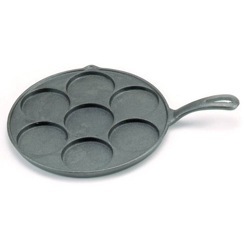
Potato cake or Pan cake pan
What pieces should you buy? While you can see a larger assortment below there is no argument that a very large frying pan is the kitchen workhorse. Following that is a large dutch oven with lid. You can cook nearly anything with those two and only those two pans. Other pans are nice but not necessary. And if you could only have one pan, pick the large dutch oven which can also be used as a frying pan. While I have hundreds of cast iron pans if I could take only one with me in some emergency it would be a large dutch oven. However, in modern times with an intact society I use the frying pan the most. If society fell apart it would be the dutch oven.
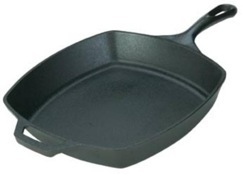
Square skillet
Other pans are nice to have, among them a roasting pan, grill pan, and muffin pans. Indeed, my mother who is 86 is still using the cast iron muffin pans she had when I was a kid that she got from her mother. Not only is that family history but low cost and environmentally reasonable in that you are not buying new pans every few years.
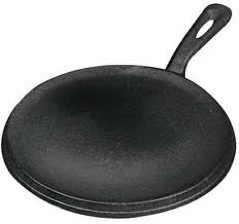
Pancake griddle
Old and New
First you want a pan that sits flat on a flat surface. No wobble. A wobble means it is warped and will heat very unevenly on a flat surface (however, if the pan is to be used only on a camp fire and is dirt cheap, the wobble can be overlooked.) Next you want a pan with as smooth a cooking surface as possible. Big pits cannot be restored and food sticks to them. (Again, if you only going to heat water in a pot, the pits are no problem. )
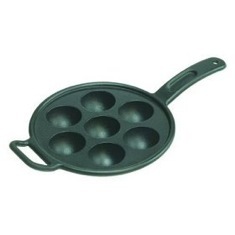
Swedish Aebleskive Pan
You want a pan that rings well when hit (see my video on said.) If you hear a buzz — read there’s a crack — or no resonance — thin metal — you don’t want it. You want a solid pan with some weight to it. No lightweights allowed.
Small frying pans are cute, and can be spoon rests, but I’ve never found any practical use for them nor cookie pans of different design, but then again I am a lifelong bachelor with no one to cook cookies for.
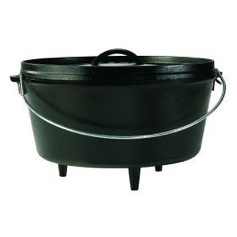
Camp oven, with legs and flat lid for coals
Unfortunately cast iron pans that used to be dirt cheap are now hot items and command very high prices. A complete Griswold dutch oven with lid and trivet can run $200. To get around that one can find them in toto or in parts at recycle centers and restore them. Complete sets command high prices but you can put sets together by piece meal if you exercise some patients. Also, anytime anyone wants to get rid of a cast iron pan speak up for it. Many people don’t understand cast iron so they don’t use it and often just give it away. Take it. It might be a collectable, can expand your collection, or, you can gift it to someone else if you don’t want it. I often pick up junked pans, clean them up, and give them away.
Griswold was bought by Wagner who also made good pans, but not as sought after as Griswold. Griswold are the collectables. Now only Lodge makes cast iron pans in the United States. While there is nothing wrong with Lodge pans I do not prefer them for several reasons. They are no doubt well-made and the value good. I do own a few. Yet they are heavy and large grain iron which I think requires more work to season. But I certainly prefer them over many foreign brands.
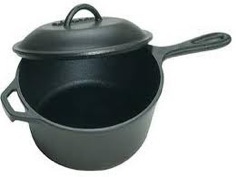
Two quart sauce pan with lid
When it comes to cast iron pans made in China and the like the quality can vary greatly from extremely poor to useable. Poor pans will have casting marks and often sharp edges that weren’t ground off. They often have a brown tint — not rust — to them and are often very grainy.
There is nothing wrong with a no-name cast iron pan as long as it is well made. The exterior iron will look smooth, the cooking surface will be even smoother. It will be black or gray, not brown (excluding rust.) Some Asian pans have a milled cooking surface with circular scoring. They are light weight and work reasonably well. Don’t pay a lot for them, however. On the other hand, if you are truly particular you can even custom order cast iron pans from a Canadian family-owned company.
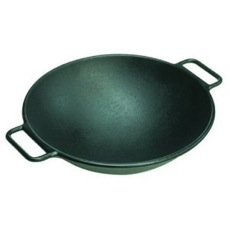
Two handled wok
You can also buy cast iron pans from Europe that are enameled on the outside. Very expensive, chip easily. They are good pans but way over priced. The only cast iron that is enameled that you might consider are Japanese tea pots which are coated on the inside to keep down rust.
One pot not to buy – see below — is a humidifier that was made to look like a tea pot. It’s a disgusting deception. They hold a couple quarts of water and have a cheap lid on a pivot. They are very heavy, have an oversize spout, and are unmilled inside. They are not made for making hot water. They are humidifiers made of poor iron often with toxic impurities. Real cast iron tea pots are small, well designed, smooth inside, not large or bulky. These knock-offs are often sold for about $20/$30 in antique malls. If you really want a cast iron tea pot, consider several Japanese models.
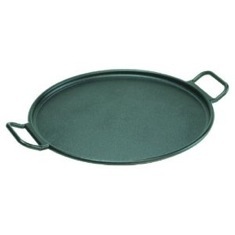
Pizza pan or pancake griddle
There’s a huge array of cast iron pans, standard and custom. But there are some general things to look for.
Pans with a raised ring on the bottom were made to use on a wood or coal stove with removable lids. One would take the lid off the stove and put the pan in its place, exposing the bottom of the pan to the fire. These don’t work as well as flat bottom pans on electric stoves. Also, while pans are numbered et cetera numbers and size do not have to agree. A #8 pan can be 8.5 inches or even 10 inches.
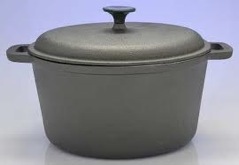
Dutch over, no legs, rounded lid
Dutch ovens are large pots with lids and a flat bottom, made for stoves and ovens. Camp ovens, same size, have short legs to hold them above fire coals. They also have lids with rims to hold hot coals on top for even cooking, particularly of breads and the like. Older pans often have lids that double as frying pans. A lot of veteran campers don’t like camp ovens because a leg can get knocked off then you have to knock off the others and sand the stubs smooth.
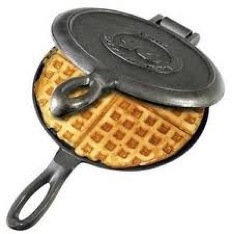
Waffle pan
Numerous muffin pans were made. You will probably find many shaped like small ears of corn. Season those carefully because they are a little harder to clean than usual. Half a log muffin pans are usually older than doubles. There are also some nice french bread loaf pans from China that work well.
Harder to find but worth the effort I think are pans with a bail. In the winer months I do a lot of cooking with my fireplace and the bail with a wall-mounted swing arm is very handy. These pans are also useful over camp fires and the like. Many bailed pots are also rounded on the bottom for use as soup pots or stew pots.
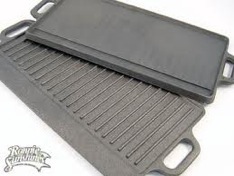
Two sided griddle
Also look for extra handles and pouring spouts particularly on frying pans. It makes using them much easier to use, especially for women for whom heavy pans require two hands. Dutch ovens with extra handles and spouts are nice but not necessary. Conversely, do not by any pans with wooden handles. Such handles limit their use. You can’t put wooden handled pans in the oven, which is often done with cast iron. You also can’t use them over an open fire. The handles will burn off. You can use a pot holder on the handles or pick up inexpensive handle covers for the pans.
Some pans sold through regional foundries have dimples on the outside. It’s a clue to their identity and does not affect their function.
Restoring and Cleaning
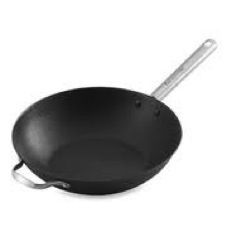
Light wok
There are several ways to clean cast iron. Unfortunately too many people are just too macho about it. Before the Age of Enlightenment folks just tossed a pan into a roaring fire. That will burn off rust and crud but it can also warp the pan and damage the surface making it worthless. It is a sledge hammer approach and just not necessary.
Lye-based oven cleaners work but involves harsh chemicals. You put the pan and the cleaner in a plastic bag and set it in the sun for a few days. They are dangerous, rough on the pan, not to nice for the environment and costly. A pan is not an oven.
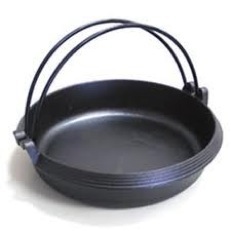
Two-bail Japanese Frying Pan
Soaking the pan in vinegar, or vinegar in the pan, works well but you have to watch it very closely. In a matter of hours it can etch the surface. It’s not a bad alternative but it is something you don’t do and leave. You check on it like a sick child.
Slightly dirty pans can be cleaned with coarse salt, a little oil and a plastic scrubby. One rarely needs grand abrasives. Sand blasting a pan is on par with throwing it in an inferno. Kinder, gentler works.
I prefer cleaning pans by electrolysis. It’s a simple, effective, and cheap. There’s all kinds of websites about it so I’ll just cover the basics. You put the pan in a liquid and send a low-voltage current through it. The current creates bubbles that cleans the crud off the pan and the current helps exchange ions getting rid of the rust. It costs only a few pennies a day and is totally friendly to the environment (see my video for more information.) It also can restore a pan, actually add some iron to it instead of taking it away. It can be set up in a five gallon bucket usually with stuff found round around the home. In fact, three 50 watt solar panels adding up to three amps can run your electrolysis vat. Now that’s really green.
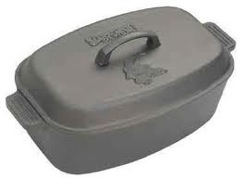
Oven Roast
When I am done cooking with a pan I simply wipe it out. I never wash my cast iron pan basically because they don’t need it. Sometimes I will put a little water in a warm pan to help clean it but never soap. You can use soap but usually it is not needed. Once clean I coat the pan with some oil. If I am going to store a
pan for a very long time, months in a wet climate or years, I coat them with pharmacy grade mineral oil. It doesn’t hurt the pan and what is left after you wipe it off doesn’t harm us. Also, all season pans should be store with a paper towel between it and the next pan. This reduces surface damage and moisture that can promote rust.
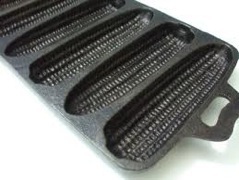
Corn muffin pan
Perhaps no other related topic is so rife with garbage on the internet than the seasoning of cast iron pans. It is cancerous with political correctness and completely removed from practicality. I think the worst that I have read was someone selling new pans and (proudly) saying he seasoned them with flax seed oil. Flax seed oil? That is just about the most unstable polyunsaturated oil there is. It is so unstable — read easy to oxidize — one never cooks with it, ever. To subject it to high heat for seasoning can create dangerous compounds and guarantees lousy performance. It is difficult to express just how stupid that is. I’ve also read where people spray a pan with no-stick spray then throw the pan in the oven at 500F for three hours, a pointless expensive exercise that might burn the house down.
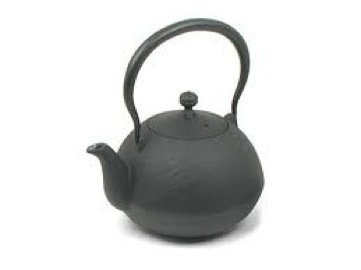
Japanese tea pot enamled inside
While I mean no disrespect to my vegetarian friends, vegetable oil is a poor class of oil to season a cast iron pan with. It gets gummy and it oxidizes leaving your pans with a rancid aroma and taste. The original is still the best, lard, also known as pig fat. My second choice would be tallow, either beef or lamb. The next question is why?
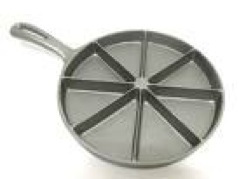
Corn bread pan
Animal fats are saturated, which means there is no place for an oxygen molecule to attach. It is oxygen that oxidizes and makes oil smell rancid. Lard is the most convenient fat to season with because it is comparatively cheap and widely available. It is easy to work with and produces superior results. If you absolutely must use a non-animal fat to season with, use coconut oil.
So with the choice of fat out of the way, what is “seasoning?” Simply put, the surface of the iron pan has minute pits in it. Seasoning is giving the surface a coating of carbon molecules which are not as sticky as untreated iron. Instead of a factory putting on a coating of non-sticky teflon (at around 600 degrees) you are putting on a non-sticky coating of carbon at moderate heat. If you look at my video you can see exactly how I do it.
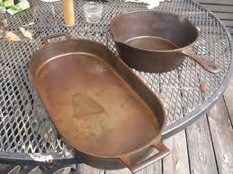
Open oven pan and sauce pan
I put the pan over moderate heat outside and constantly coat it with a light sheen of lard. When the pan loses that luster, within a few seconds, I add another coat. The pan smokes constantly. But over the course of a half hour to an hour the pan gets an excellent non-stick surface. If the flame is too hot, it will burn the carbon off. If too low the fat won’t carbonize. That is why moderate heat is best. Several layers rather than a one-shot oven deal is far superior as well. It may be a small detail but it is one that directly affects the function of your pan, the life of it, and ease of cooking.
While I don’t have to here’s what I do with every pan I season. After seasoning I cook a few pounds of bacon in it over a week or two, leaving the fat in the pan. By the time I am done nothing will ever stick to the pan.
Cooking
You can cook anything in a well-seasoned cast iron pan, from eggs to fish to steak. I do add fat, oil, or non-stick spray to the pan every time I use it as I would any frying pan. The pan is not totally stick-less but rather you want the food not to stick. If you crank up the heat real high and forget to put something in the
pan your seasoning will burn off. But, if you season, use a fat or oil and cook regularly with it, the pan not only is as good as non-stick pans but it gets better with use and age. Treat it right it treats you right. This is not a use and throw away pan. It feeds your family and it needs some care.
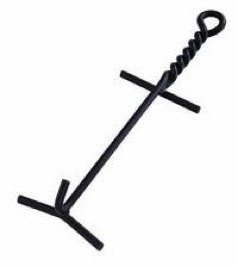
Hook to lift lids off campfire pans
There are, however, two things you have to watch. Acidic foods, like tomatoes, can be cooked in such pans but not left in them after cooking. The same rule applies with any liquid. You can cook a soup or a stew in a seasoned cast iron pan. Just don’t leave the liquid in the pan when you’re finished. As always when done cooking, wipe the pan clean and dry.
And it is here I should add one remote concern especially if you cook a lot of acidic food. The pants do leach iron into the food you cook. For most people this is not a problem, even a health benefit. If however you have too much iron in your system or you are a man sensitive to excess iron (which can cause heart attacks) then cast iron is not the pan of choice for you. Most people know their condition already so excess iron from cast iron is not a common problem.
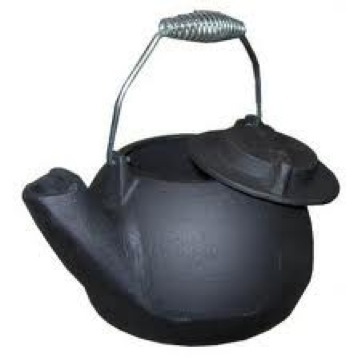
Humidifier, NOT for heating water to consume

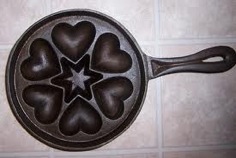
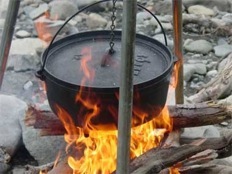

What is the name of the Canandian Co that can make a custom piece> I need something about 3 to 4 feet in diameter and about 4 to 6 inches deep. Any help in finding a source would be greatly appreciated!
Dear Sirs,
Good day!
We are the supplier of cast iron (cookware, teapot, trivet, bathtub etc.)
Please feel free to contact us if you need those products.
For more information, please visit our website:
http://www.dingjiametal.com
Regards
Jessica
TEL: 86-0311-86218098
FAX: 86-0311-86218098
Hello,
You seem to know your stuff when it comes to cast iron! I just bought one today at an estate sale and I do not recognize the maker. It looks old, small frying pan and the symbol on the bottom appears to have a crown with a flleur de les inside of it. There is more to it but I can not make out more than that. Do you know who made it? I assume it is French or perhaps Canadian? Any ideas would be great.
Thanks!
Julie I have pictures of a cauldron with a crown also would like to share pictures if we could. I don’t seem to be able to post the picture on this site.
You can on the Green Deane section of the site.
cast iron stuff is actually not terribly hard to come by here in australia if you know where to look. there is a place called aussie disposals that sells surplus military clothes and other camping stuff including propane equipment and they sell new cast iron stuff. i have even seen wood fired (sheetmetal) hot water systems for sale in this store in large country towns. i used to work at a sandblasting place and we would occasionally get cast iron stuff to blast, as well as cast BBQ hotplates.
i was thinking this week that I have heard in the USA that quite a few junkyards/ scrapyards / scrap metal places let you look through their stuff, and you may find some someone has flung out there, or the yard owner may have put aside some himself that will be in his pile of “good stuff”. here in australia the scrapmetal yards don’t allow that and are very high volume type places.
I also need the name of that Canadian company as I need half a dozen custom items
Unfortunatley they have go out of business.
Hello Dean, My IQ went up when I read this post. Thanks John V.
I found a great campfire cast-iron cooker.. It looks like a flattened out wok.. it only has about a 1/2″ dip in the middle though.. and it has cast iron legs that screw in…. makes perfect bacon over a campfire (coals) and when the bacon is done it leaves a film of bacon grease, more toward the middle so that you can throw on eggs and kick up a little grease as needed (very tastey)… I like to cut off pieces (squares about 1/4″ thick) of chedder cheese and throw them in the bacon grease to fry.. fried cheese… omg.. so good…
Is there a cast iron cook stove or cook box to throw in pine cones, sticks to burn, and then with a flat surface to put a cast iron or stainless steel pan on? Reason: to cook with small fire inside the box, not a campfire.
A wide variety of such things are made for camping but not out of cast iron because they would be very heavy. My Greek relatives high in the southern mountains cool on a one burner cast iron stove. Small but I would not want to carry it far.
A Rocket Stove would do this very well for you. There are commercially made ones or you could build one yourself. There are lots of websites and YouTube videos about this.
Rocket stoves burn sticks and twigs, very hot, efficient and virtually smoke free. This recent technology was developed to replace open cooking fires in third world countries. Rocket Stoves have been made with cans, barrels, drums as well as bricks and DIY low density concrete.
A similar, but much older idea is a Dakota Fire Pit. This could be operated like a Rocket Stove (feed small sticks into the air intake side) with no cost or materials, just two holes in the ground.
Both of my parents liked cooking and they both used only cast iron cookware. I picked up their love for cooking as well as their love of cast iron. The one important thing about cast iron is never use any soap in cleaning, simply rinse out with hot water and completely dry out. Then swab with bacon grease or crisco to coat and heat till hot, turn off the heat and it’s ready for the next meal.
Over time you will find that the more you use your cast iron cook the better the seasoning it develops as it transforms into cookware far superior to anything you can buy. The key words are patience and persistence and your rewards will be like a fine wine.
as we were sitting around the night we got in the discussion of Griswold Dutch ovens. I have one that says it is a #8 Tite Top with the large emblem on the bottom with block lettering. I found on another site that it was manufactured between 1919 – 1940 it was my grandmothers from TN. is there any way to get a little closer on the date is was made. It is in amazing condition (like brand new) looking. What is the value?
I have a 6 mold cast iron muffin pan that has a boy sitting against a hay stack, a southern girl wearing a hat, one of a girl holding a cane (little Bo peep maybe), a lady holding a bowl, a boy holding a ball and the last one looks like a child or clown. It could be a nursery rhyme theme and I cannot find another one like it anywhere and was wondering if anyone has seen one before. Looks to be very old with no markings.
I recently found a Griswold Dutch Oven and want to clean it using electrolysis. I am wondering if that will damage the wire bail handle. Please let me know your experience in this and any tips that you have. thanks!
It shouldn’t damage the bail.
I have collected great old pots & pans at junk stores, GoodWill, garage sales, auctions. Most are covered in rust, but remember, rust is self-limiting. I have never needed more than salt-&oil scrub. No soap EVER! Have used cast iron in camp-fires, wood and coal ranges, gas & electric cooktops, and, best of all, magnetic induction cooktops. A cast iron pot is truly “a pan for all seasons”. (Please forgive the pun.)
I have an 8 inch skillet that was my Mom’s which I use all the time. I would like to remove the build up on the outside of the skillet. The build up is from her using it in a wood stove as she grew up. Any ideas? The cooking surface is fine.
Outside is of little issue. A drill and a wire brush should work fine.
I love cooking on cast iron. The Lodge brand was a bit expensive for me so I bought a set that came in a crate from Camping World. This is what the description is for the set: Cast iron is heavy-duty, more durable and retains heat longer than conventional cookware. Versatile set includes a 2 qt. Sauce Pan, 6 qt. Dutch Oven with bail handle, 12″ Skillet and pot lifter. The 20″L x 9″W Griddle is ribbed on one side for broiling, and smooth on the other side, for pancakes, eggs, and more. All pieces are easy-to-clean and can be stored and transported in their attractive wooden CW Gear box. Also included are carrying cases for each piece of cast iron cookware. $75.
I haven’t bought one yet, but I think the cookware would do very well on one of those induction stovetop burners.
I have been enjoying all the great articles here and wanted to throw in my two cents. Seasoning works just as well on cookie sheets. I never need parchment paper and all that I cook on them comes off easily. For the cookie sheets we use, we just showed restraint in washing them and after a few years a beautiful black sheen has built up (except where the pizza cutter leaves lines on our biggest sheet).
If anyone can answer this question, I’d appreciate it. I was wondering if I have already baked on a few layers of seasoning using Crisco shortening, can another layer of a different oil be baked on subsequently, or should the pan be stripped to bare metal and then the new oil used?
You can use other oils though polyunsaturates are a poor choice.
Thanks for nice sharing. You can also find best Cast Iron material at Laxmi Iron & Steel Industry. The main object of LAXMI IRON & STEEL INDUSTRIES is to provide best quality and cost effective Cast Iron. For more information Visit Cast iron Suppliers.
I am in need of a new wooden handle for one of my cast iron skillets, where can I get one. I only use cast iron.
Please help me…
I just purchased a Griswold waffle iron set. circa 1901. The handles are missing. I suspect they could have been wood to be used on a kitchen stove not a camp fire. I don’t have the iron in my possession yet. There is a circular handle receiver ( female port) with a hole for perhaps a pin or ribbit. The handle would have slipped into this and thus secured by the pin. Or perhaps just a thought. They could have been cast with a number 9 wire spun around the handle ( like a spring) to remain cooler. Your thoughts? They need a good seasoning as they show signs of light trust from the sight of the seller.
I have a Griswold 609G handle griddle, it had belonged to my mother, which I inherited. It is useable, but pitted, I read why, do to using veg oil, can anything be done to repair it? Thank you, Mike
Unfortunately once pitted they are permanently pitted.
Hi,
I am lucky to have a “European Style Cooking Hearth” fireplace. I use my cast iron pans in/over coals, as well as hang kettles from the ‘crane’. I cook in the fireplace off and on throughout the fall and winter months; when I have a fire going. I also utilize it when we are experiencing a power outage.
My ? is:
I just purchased a “CAST IRON STAR TEAPOT KETTLE, # 8 SWING TOP”.
It’s really clean….. No pits or rust…. I want to use it in my fireplace for heating tea-water.
Should I, or shouldn’t I?
What do you think?
Made where?
Ivery inherited two old Griswold cast iron skillets from my grandmother. One is inot great condition, the other has what looks like carbonized crust all over the bottom, I originally thought the iron was pitted but it doesn’t appear to be. Also the cooking surface has several spots where the black season layer is flaking off and the Grey iron can be seen. I know the pan needs to be cleaned and re-seasoned but I am not sure of the best method to clean the pan.
I just found a Bangor Foundry & Machine Co #8 tea kettle at the dump. It’s bigger than my 11 year old’s head, but the walls aren’t super thick. Would you think it more likely that it’s a humidifier?
Thanks for your time.
The “tea kettle” I have that is for making humidity is crudely made and from China. I don’t think our domestic companies were making cast ironware for humidifying, at least not shaped like a tea kettle.
I was hoping you’d say that. If my research is correct, this thing could be over 100 years old. Nothing definite, though. I’m looking forward to restoring it.
Thanks again!
Forgot to mention: the inside is smooth, like my pans. It seems like it should be for food.
I am an old timer now and I grew up with cast iron and still use it. I have several pieces and if I find a new to me item I have a special treatment for it. Takes a lot of work. First Emory Paper not Sand Paper. Use it to polish the inside. If it is a Chinese one with the machine marks it will take a lot of work to get those marks out. If it is just old and pitted then a little less work, Rusty then more but work until it is a nice patina grey and smooth. If it has a wooden handle then remove it. Now clean the pan well with a rag that has lard on it to remove loose iron filings. Coat the pan well inside and out with lard and bake in an oven at 350 degrees for a half hour. Recoat the inside with lard again and bake for another half hour. Do it a third time and then let it cool. Wash it once with Soapy water and then rinse well and place it on the stove top on a low heat to evaporate the wet. As soon as it is dry then turn off the heat. Your pan is now ready for use. I like my pan with the wooden handle but it is only ever used on the stove top. However I own Cast Iron utensils that have been handed down to me by both my Mother and Grandmother and are well over 100 to 150 years old. I cook exclusively with Cast Iron. My wife works and I am retired so I run the kitchen. I have one frying pan that was a lumber camp item and it is a 36 inch cast frying pan, weight 42 pounds. I cook with it only on holidays when a large meal needs to be prepared, the rest of the year it hangs by my drum set and is a fantastic gong.
Thanks for writing and sharing your experience and methods.
Thank you for mentioning the use of Emory paper for polishing the inside of a rough pan. I grew up using my grandmother’s cast iron pans and loved them. I don’t have time to shop the yard sales and garage sales, so all of my pans are store-bought. I was told Lodge was a good brand, but the interior of mine are very rough. I have tried every method I have heard or read about over the years and nothing has made the largest pan completely satisfactory. Even bacon sticks. I am now going to try your Emory paper idea for smoothing and then lard, as you used it in the oven method. I have never had anyone to suggest emory paper. If it works, you are my new hero!!
Supercool they are getting ”cool” again. That sucks very expensive and hard to find quality second hand 🙁
hi,I am a iron cast cook ware manufacturer with FDA standarts in TURKEY and would like to know if these products are interesting for you or not.If yes,I will be glad to send all needed detailed informations.thank you
I am a dealer in cast iron. Can you send me some pictures etc.
Hi there Greeman,I have been collecting cast iron cooking ware for to long to remember some of my pots/ pans have been stored for years, with no rust or other afflictions. I use the same lard protection as you do with one small difference, after drying the pot or pan I fill the pots / pans with balled up news paper. If I use the pot or utensil again I simply wash it in warm water dry it and restore the balls of news paper in it, to be used at a much later date.
Hi Green Deane, interesting comments, but still doesn’t answer my question. I have 2 cast iron muffin tins (each muffin space is the shape of an acorn). I n 2007 our house burned down, lost every thing but those 2 muffin pans I was able to dig out of the ashes and rubble. I didn’t know if I could use them again. I put them in a container and stored away, I want to use them again so bad. They are blackened and rusted somewhat. I didn’t know if I put them in the oven if they would start smoking and smell the house up, I’m afraid to try. Should I at least try without anything in them? I also wondered if when I do make muffins in them will they taste like smoke? Thank you!
I need a couple of replacement nails for pots. Where can I find them?